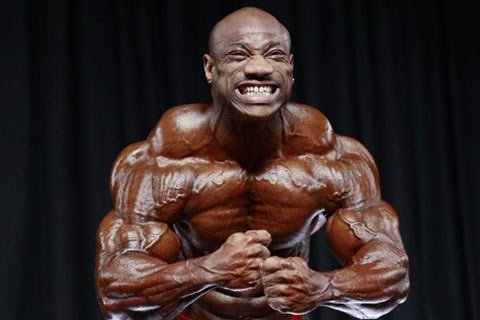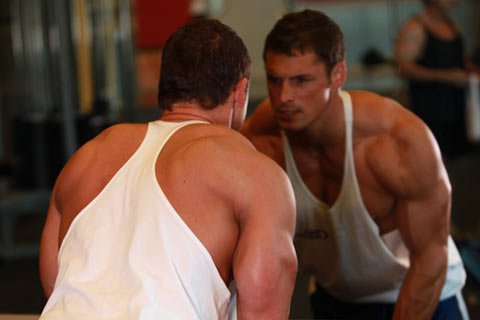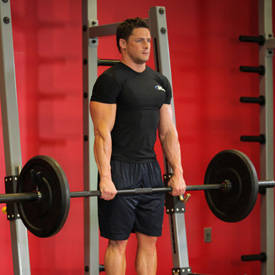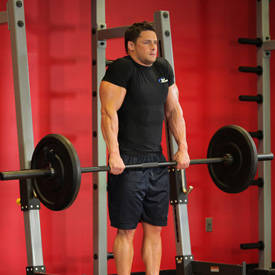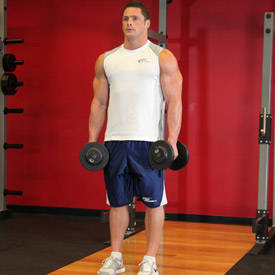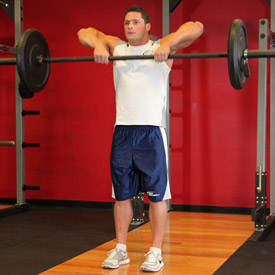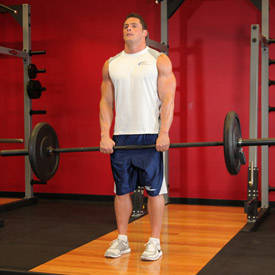| Article Summary: |
So you've got a gigantic chest, you've built cannonball delts and your lats stretch so far your 20 inch guns can't reach your side anymore. But looking in the mirror you realize you look ridiculous and instead of exuding power as a man of your stature does, you look like a 220 pound wimp. Your head is sitting atop of all that meat, but it looks like it doesn't have control. And then it hits you, you don't have any traps. The traps are a muscle that is often overlooked because of its positioning.
It's not in your immediate vision and you fail to recognize them as a separate muscle because you use them in lots of other lifts for almost all other upper-body work. But the difference between you and the look of a real bodybuilder is huge, monstrous traps overshadowing your clavicle, thickening your back and engulfing your neck. Images of that green giant the incredible hulk flash through your mind, defensive linemen stopping speedy receivers and impressive most musculars. So let's get to working those traps...

Defining The Muscle
Not many people realize that the traps are in effect one large diamond shaped muscle that attaches at the top of the neck, spreads to the shoulder attachment along the clavicle bone and all the way down to the middle of your back, tying in your shoulders and lats. If perhaps we could make more people understand that the trapezoid muscle is larger than the abdominals, something most bodybuilders put a lot of work in to, the they wouldn't neglect training it so much. Of course options are limited to its training, the muscle isn't extremely visible most of the time and it simply doesn't feel like an individual muscle. But the reason for that is its function in almost every other muscle group. It all starts to dawn on you when you understand just how important the traps are.

Physiology Of The Muscle
As explained before the trapezoid is a large diamond shaped muscle placed on the upper back and shoulders. It's also known as the monkshood muscle. If you look closely from the rear and imagined an actual hood attached to it you can see how it resembles and covers the exact same places on the body a medieval monkshood would. The relevance of the muscle is that it carries or assists in all lifts that go from a lower point to a higher point. So in most back lifts, if they go below horizontal, you will assist with your traps.
In resisting the pressure of overhead lifts for shoulders and chest your traps will come into play as well. The other function is to counter the action of the chest. Whereas the pectorals move the arms in front of the chest, the traps move them out of that position and allow you to retract or open your arms. That is why the traps are worked to a large extent as well when back rows and rear lateral raises are performed. To put it in a simpler wording, it is what retracts the scapulae.

Neglect
The traps are trained in a very simple manner and they are perhaps the most effective muscle in the body. Its hard to believe that you couldn't train this correctly since they respond even to the shortest amount of exercise provided you give them the necessary stimulation. The only ways you can have a lack of growth in the traps is either by not using enough weight to stimulate the fiber or by simple neglect. So the problem rests squarely on your shoulders...literally.

When To Train The Trapezius
It's long been an issue of whether to train the traps with the back or with the shoulders, since both recruit the traps to a point. Giving traps a separate workout is crazy because you would be over-training it (it is used almost every upper body day) and the training doesn't really qualify it for that kind of intense focus. Especially since it grows really fast. So when to train it? Well, I believe that including upper traps with back is overkill.
Adding more sets to a workout that should be your biggest of the week is asking for trouble. The lower traps are mostly worked in back exercises and since you need to target them with all kinds of rows, it makes sense to just go hard on those and not particularly worry about lower traps. Should this be an issue however you can hold contraction on some of your rows for few counts to emphasize it or do seated cable shrugs at the end of your workout.
|
|
|
|
|
To do these simply sit down as you would for seated cable rows, but keep your arms straight and simply pull the shoulders back. This will retract the scapulae and really hit the inner and lower traps and stimulate thickness in the upper back. This can also be done using other kinds of rows with the arms straight. The movement of the shoulder blades is achieved by the strength of the lower traps.
So the decision on when to train upper traps falls on shoulder day. Before or after? The heavy weights you use would suggest before, but this will take away serious intensity from the shoulder workout and fatigue the traps, which rules out the chance of good performance on compound lifts for the shoulders. So after shoulders is probably best. The traps grow fast provided you supply intensity and proper weight, so 8 or 9 sets over 2 or 3 exercises should suffice for the building of large traps. Especially since the choice of exercises is very limited.

Training Your Traps
The best known exercise is the shrug and all its variations. The basic barbell shrug is still the number one mass builder for this muscle. You start by holding a barbell loaded with a lot of weight in both hands, about shoulder width apart. Now simply lean in a little bit (very little just so the bar doesn't touch your legs) and try to touch your shoulders to your ears. This is impossible, but the illusion will ensure proper form.
Sometimes however it may be better to use dumbbells. My one objection to this is that you can't handle as much weight, so you lose a little intensity. But they make up for it because they allow a hammer grip which is more natural and by holding them to the side of your body you can move the shoulders up and in better providing more overall stimulation.
They are performed in the same way, except you keep your arms to the side more and your hands in a hammer grip. There are machine variations to this too, but they have little more to offer than a barbell. Free weights are still the best for lean mass accrual.
As a secondary exercise two come to mind. As a bulking exercise for putting on a lot of bulk, I find that combining heavy shrugs with armpit rows works best. To do armpit rows stand as you would for dumbbell shrugs. Lean in a bit let the weights hang down. Now, as you would do for dumbbell rows, stay close to the body as you lift the dumbbells up to your armpits.
This really hits the contraction, but a little lower than shrugs will. This really connects the shoulder girdle to the back. Sometimes using a superset of shrugs and armpit rows, say 4 or 5 will really hit the traps to total fatigue, and that isn't easy for such a tough muscle.
The second exercise is upright rows, better known that the previous one. People always ask me why I don't do these that much. Well, they don't really stimulate as much muscle and they divide the attention between traps and shoulders. So why bother at all? Well, I include them in my contest preparation routine because upright rows give you a clean separation between the delts and the traps.
That is really great up on the stage, so you have a cut physique and don't display your traps as a ramp from shoulders to neck. To perform upright rows grab a barbell, a lot lighter than for shrugs but also shoulder width apart or just outside of it. Just pull the barbell up to eye-height always keeping your elbows higher than your hands.
 Click Image To Enlarge.
Click Image To Enlarge.
Upright Barbell Row
Click Here For A Video Demonstration Of Upright Barbell Row.
The movement should be an arc in the sense that you start with the barbell against your body but move it away from it as you go up so that you have a few inches leeway between your eyes and the barbell when you get to that point. If you move your grip in you will isolate the outer traps and if you move your grip out you'll hit more of the delts and inner traps. Well worth the extra effort for those cuts!
You should always use a variation of the shrug and depending on your goals one of the other two exercises. If you feel like doing less sets per exercise you can even do both. But either way, keep the weight as high as you can handle strictly and keep reps reasonably high, 10 to 15 is ideal to stimulate the fiber in there since it is a nice combination of oxidative and glycolytic fiber so it needs a good combination of aerobic and anaerobic exercise, so keep shrugs near the top end and the second exercise near the lower end.

Warning!
If you mention dangerous practices in the gym, inevitably trap training comes up because lots of inexperienced lifters fall for the wrap of some two-time personal trainer and get caught up in doing rotating shrugs. Rotating shrugs are very, very dangerous because in the weight-range you need for proper stimulation you are wide-open to creating a chronic rotator cuff injury that could end your lifting days. So please think twice about the consequences before you try new exercises. Do yourself a favor and stay away from this one...
That's pretty much all there is to trap training. I hope you picked up some useful tips or reminded yourself of the rules of training this all-important muscle. Whatever be the deal, as long as it puts you "back" on the road to monstrous trapezoids.
Recommended Articles
 |
 |
 |
| Share This Article: |

